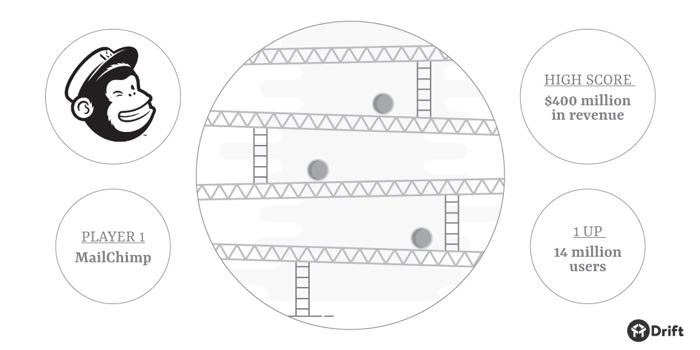
The founders of MailChimp didn’t set out to build the world’s leading email marketing software.
They didn’t start by asking, “How do we build a product that can be used by millions of businesses for sending billions of emails each day?”
Instead, when co-founders Ben Chestnut and Dan Kurzius launched MailChimp back in 2001, they were simply trying to help their customers.
At the time, the pair were running a web design business. When some of their customers started asking for a way to send emails, Chestnut dug up some old code he had written for an earlier project (a failed digital greeting card product). That code became the jumping-off point for the MailChimp email marketing service.
For years, the service remained a side project. But in 2007, Chestnut and Kurzius decided to shut down their web design operation and go all-in on MailChimp.
Why?
Because in launching MailChimp, the pair realized that web design really wasn’t their passion. As the New York Times reported, “What Mr. Chestnut and Mr. Kurzius were passionate about was helping small businesses grow.”
Email marketing, however, wasn’t necessarily the best game to be getting into for helping small businesses grow … at least not in 2007.
For starters, spam was reaching unprecedented heights, and people were becoming increasingly annoyed. (One study found that 95% of all emails sent in 2007 were spam emails.)
But perhaps even more discouragingly, better-funded companies (e.g. Constant Contact, which raised $107 million in its IPO in October 2007) were already dominating the email marketing landscape.
Still, Chestnut and Kurzius saw email as a cost-effective marketing channel — perfect for cash-strapped small businesses that were trying to reach their target audiences.
What’s more, the MailChimp co-founders had a secret weapon for taking out the competition.
“A Proximity to Its Customers”
Chestnut told the New York Times that MailChimp’s success stems from that fact that it had “a proximity to its customers that its competitors lacked.”
And he elaborated that because MailChimp “was itself a small business, it understood what those businesses wanted out of their marketing tools. Its offerings were cheaper, it added features more quickly, and it allowed greater customizations to fit customers’ needs.”
In other words, MailChimp won by getting closer to their customers than the competition.
And as you hear us say all the time here at Drift, “Whoever get closest to the customer wins.”
Flash forward to today, and it’s clear that MailChimp’s customer-driven approach has paid off in a big way: They now have more than 14 million users, and are anticipating $400 million+ in revenue for 2016.
But how, exactly, was MailChimp able to get closer to their customers than their competitors?
At Drift, we’ve identified three key areas where MailChimp was able to gain an advantage.
- A lovable brand. In a world of stark, gray, corporate solutions, MailChimp stood out for being quirky and fun.
- Freemium. The key to marketing MailChimp was to let people use it — for free — so they could see for themselves how amazing it was.
- Customer delight. MailChimp reminded its customers that they had made the right choice by regularly finding unique ways to surprise and delight them.
1) A Lovable Brand
There’s no denying that mailchimp has one of the most memorable and adorable mascots in the business: Freddie (full name: Frederick von Chimpenheimer IV).
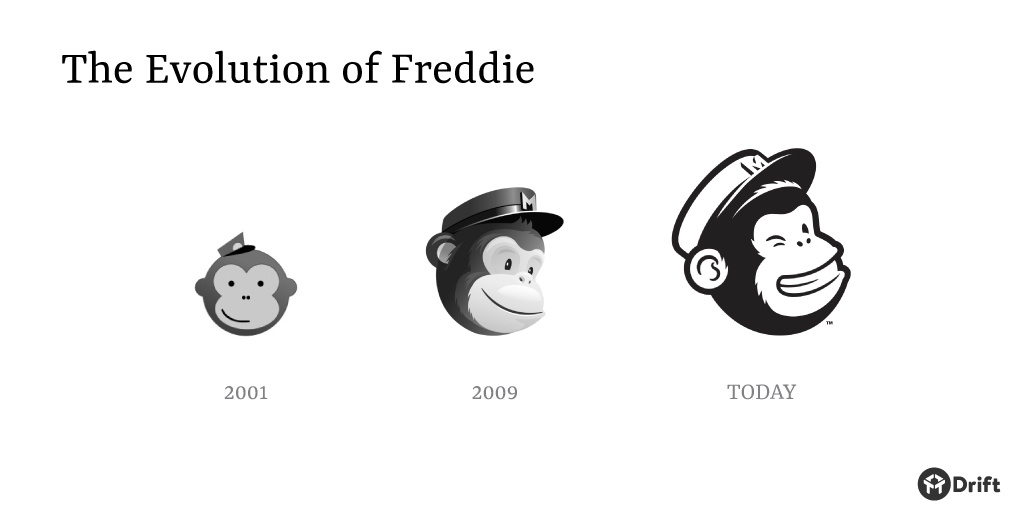
But as MailChimp marketing director Mark DiCristina once said, “having a mascot is not a substitute for having a marketing strategy.”
Ultimately, the reason why Freddie works for MailChimp as a piece of its brand identity is because Freddie is an honest representation of the MailChimp brand.
As DiCristina explained, their cartoonish mascot “represents some ideas that the whole company stands behind: making work fun, creativity, and independence.”
And MailChimp’s wordmark — with its hand-written, schoolhouse look — echoes these ideas as well.
 But to reiterate: MailChimp didn’t create this fun brand identity for the heck of it. Their branding grew naturally out of the fun experiences they were already delivering to customers.
But to reiterate: MailChimp didn’t create this fun brand identity for the heck of it. Their branding grew naturally out of the fun experiences they were already delivering to customers.
For starters, MailChimp was a pioneer in the world of witty and informal product copy. Years before Slack started dazzling us with its friendly tone, MailChimp was preaching that they could make sending great content “easier than eating a banana.”
MailChimp also wasn’t afraid of sharing a GIF when they felt the moment called for it.
Getting ready to send out an email campaign? MailChimp would show you this animation of a hand sweating over a big “send” button.

And then once you sent a campaign, guess what? MailChimp gave you a high five.
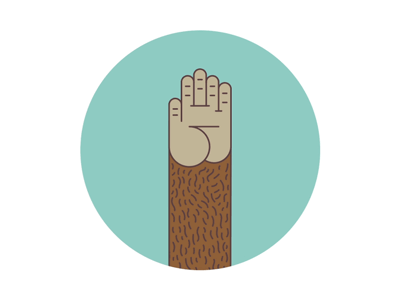
Instead of making email marketing feel like a chore, MailChimp managed to make the experience fun. And that experience they delivered — not their primate mascot — is really what set their brand apart.
Of course, the strengthening of MailChimp’s brand didn’t happen by accident. They’ve clearly put a lot of thought into nailing down their voice and tone, and setting guidelines for how their brand assets should be used.
One of my favorite examples of how MailChimp has codified the language they use comes from their content style guide. It’s a list of what the MailChimp voice is, and what it isn’t.
- Fun but not silly
- Confident but not cocky
- Smart but not stodgy
- Informal but not sloppy
- Helpful but not overbearing
- Expert but not bossy
- Weird but not inappropriate
As you can see, there’s a fine line to walk. Get too informal, and customers start viewing you as unprofessional. But for MailChimp, walking that line, and striking that perfect balance between fun and professional, paid off.
As a result of their brand-building efforts, MailChimp was able to change the way people felt about email marketing software.
The experience MailChimp delivered was warm and friendly, as if their customers were trusted friends — not entries in a CRM.
Other email marketing solutions on the market, by comparison, felt cold and robotic.
There was only one thing holding MailChimp back from conquering the world of email marketing:
Not enough people were getting the full MailChimp experience.
In order to grow, MailChimp needed a strategy for getting potential customers to see, first-hand, what being a MailChimp customer would feel like.
Luckily, they had a plan …
2) Freemium
In September of 2009, MailChimp announced they were going freemium.
Now, I could summarize the reasons why MailChimp made that decision, but considering their announcement post was just a few-hundred-words long, you might as well read it yourself:
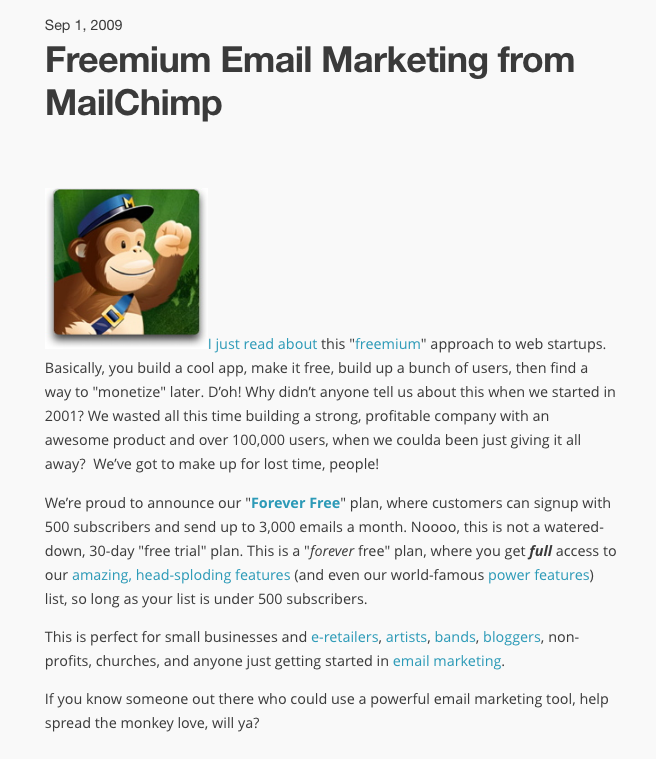
In true MailChimp fashion, the post (written by co-founder and CEO Ben Chestnut) opens with a tongue-and-cheek commentary on how MailChimp had “wasted all this time” building a profitable company and an “awesome product” that had amassed a user base of 100,000 people.
Chestnut’s point here is that MailChimp was successful well before it chose to go the freemium route.
This wasn’t some lucky gamble — it was a calculated move.
As Chestnut wrote in 2010:
Ever since inception, I’ve been fascinated with the art and science of pricing. I’ve tinkered with pay-as-you-go and monthly plans for $9, $9.99, $25, $49, $99.99 and so on. We’ve changed our pricing models at least a half-dozen times throughout the years, and along the way we tracked profitability, changes in order volume, how many people downgraded when we reduced prices, how many refunds were given, etc. We’re sitting on tons of pricing data. When we launched our freemium plan in 2009, you betcha we used that data to see what would happen if we cannibalized our $15 plan. If we had started with freemium at ground zero, the story would’ve been different.
Ultimately, the MailChimp team had the benefit of being able to study all of this data they had amassed (presumably) since they launched in 2001.
And the conclusion that they came to was that offering a free forever version of MailChimp was the best strategy for driving growth.
For Chestnut, however, the underlying inspiration for going freemium grew out of an experience he had at a Ben & Jerry’s. When a friend took him there for the first time, and he got to try all of the free samples, he was hooked.
I walked out of there with a cone of Chunky Monkey (of course) and have been a fan of Ben & Jerry’s ever since. That, in a nutshell, was my inspiration and motivation in offering the freemium program at MailChimp. We’ve worked hard for many years to build a powerful service that actually makes email marketing fun. And I want the entire world to experience that fun. It’s also kind of a cool idea to think of bajillions of “serious” business newsletters being distributed with little monkeys in their footer.
Catch that last line? The “little monkeys in their footer”?
That actually proved to be one of the most brilliant tactics MailChimp deployed as part of launching their “free forever” plan: All of the emails sent by MailChimp’s free users were stamped with a hyperlinked image of Freddie, which would send folks to MailChimp.com.
This helped drive product virality, as recipients would click on the friendly face of MailChimp’s mascot and end up learning more about the company and their software.
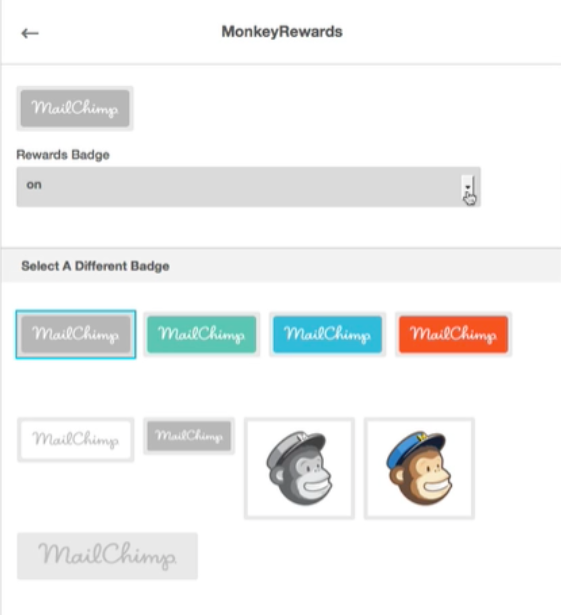
The free users who were sending those emails, meanwhile, would earn “MonkeyRewards Credits” every time a person they referred through their MailChimp footer badge ended up becoming a paying customer. Free users could then put those credits toward MailChimp services like inbox inspections or even future bills if they decided to upgrade.
One year after adopting this new, freemium model, MailChimp shared some data on their blog:
- They had grown their user base 5x, from 85,000 in September of 2009 to 450,000 in September 2010.
- The company was adding more than 30,000 new free users and 4,000 new paying customers each month.
- MailChimp’s profit, meanwhile, had grown 650%. (And yes: that’s profit, not revenue.)
According to Chestnut, that extraordinary growth in profit was primarily a result of their customer acquisition cost (CAC) dropping. At the time — September 2010 — Chestnut reported that MailChimp’s CAC was less than $100.
Jump ahead to February 2012, and MailChimp’s user base had grown from 450,00 to 1.2 million. On average, they were adding 5,000 new users every single day.
Clearly, MailChimp’s freemium sales model, coupled with its already well-established and lovable brand, helped take the company’s growth to the next level.
But in order to sustain that growth, and to prevent churn from creeping in, MailChimp had another trick up its sleeve.
3) Surprise & Delight
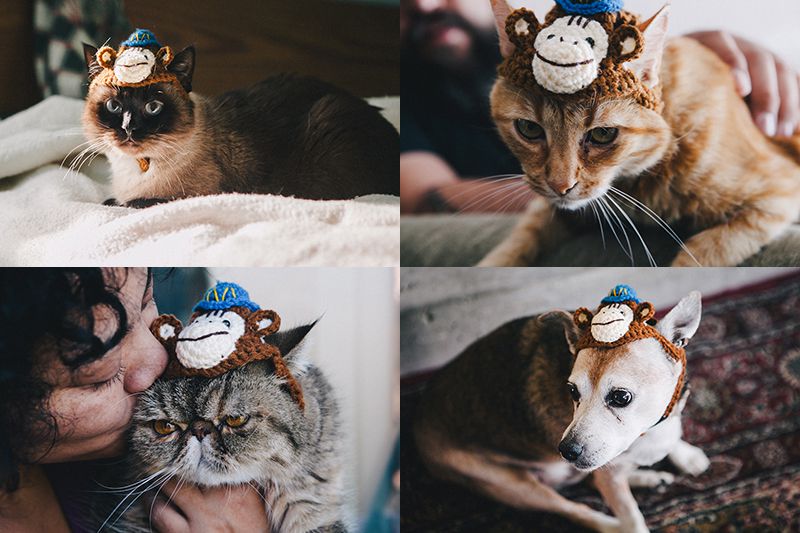
Whether it’s sending customers t-shirts, stuffed animals, or monkey hats for their cats (yes, seriously), MailChimp is renowned for its “weird swag.” Or at least that’s what a 2012 article from Wired called it.
In that same article, MailChimp marketing director Mark DiCristina explained that MailChimp creates and shares this “weird swag” because it makes people happy. There’s no other angle. They don’t have a dedicated swag data scientist crunching numbers behind the scenes.
They’re not measuring monkey hat conversion rates.
Instead, MailChimp simply thinks of them as gifts.
To quote DiCristina:
There’s no way to directly measure the impact of giving away shirts and hats, and that’s OK with us. Thinking about them as gifts changes our perspective, too. If we considered them primarily marketing expenses, we’d want to figure out how to minimize cost and maximize the brand effect—essentially, we’d be thinking about ourselves. As gifts, we think first about the recipients and about how they’ll feel when they receive the gifts. So we go over the top to make people feel special.
For MailChimp, the quality of the gifts they give to their customers is more important than the cost.
And while MailChimp employees don’t spend time trying to quantify the effects of their gift-giving, they do spend time testing out gifts to make sure they’re top quality.
As Wired reported, it wouldn’t be uncommon to see MailChimp employees, “testing the softness of a stuffed chimp’s belly.”
It might sound a little cooky, but the attention MailChimp pays to these tiny details is what helps set their customer experience apart from the competition’s.
As DiCristina explained:
The quality of our merch is a direct reflection on MailChimp and the people who worked together to create it. We’ve got to keep the bar high for ourselves, so we take the quality of our merch really seriously. [For example], as much as we love our shirts, we recently started wondering if we could make them better. Instead of starting with blank shirts, what if we source the fabric and cut them the way we like, too?
The broader takeaway here isn’t that you should start putting more budget toward t-shirts and stuffed animals, it’s that you should look for ways that you can surprise and delight your own customers based on what you know about them.
For MailChimp, it made sense to pursue a customer delight strategy that was silly and lighthearted because that’s the experience they were known for delivering — that’s what was already resonating with their customers.
But, as a hypothetical, if you’re an internet security company that’s built a brand around being trusted and taking responsibilities super-seriously, sending a bunch of stuffed animals to your customers might not play so well.
(Alternatively, a free security audit and/or free access to a new product feature might be better options.)
Ultimately, the specific tactics you use for surprising and delighting your customers should be an honest reflection of your brand.
Final Thought: Stay Tuned for More
At Drift, we have a list of companies that we look to as role models.
MailChimp, as you’ve probably figured out by now, is one of them.
In the months to follow, we’ll continue to showcase companies that have achieved extraordinary growth through getting closer to their customers.
In the meantime, you can check out some of our earlier stories about companies we love:



